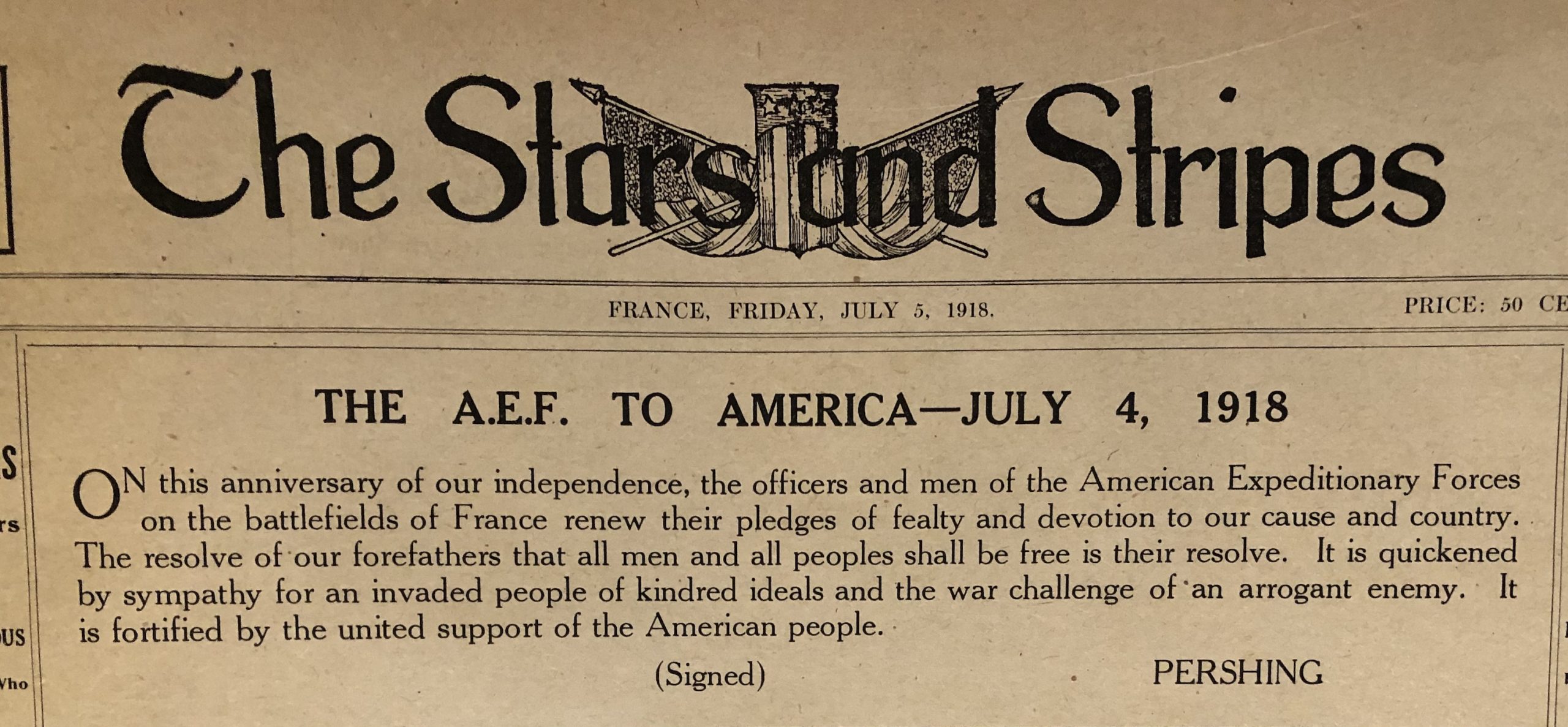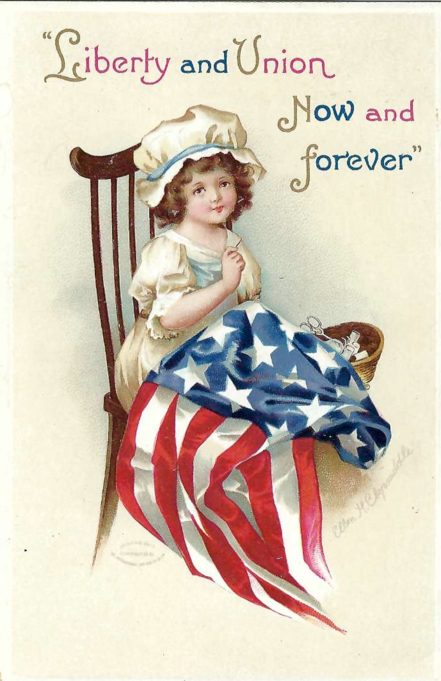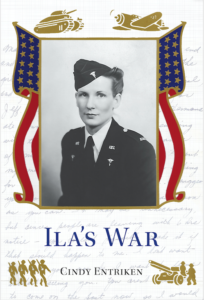For this July 4th, 2022, I thought I’d share with you some material I found in the June 28 and July 5, 1918 issues of the Stars and Stripes, France.
But before I do, let me tell you a little bit about The Stars and Stripes. The first issue was published on November 9, 1861. I’d love to have one of those first issues. But I imagine they are rare and expensive if I could even find one! Below is a brief history of the newspaper from a Library of Congress website.
History of The Stars and Stripes
In November 1861, Union troops under General Ulysses S. Grant defeated Confederate forces in Bloomfield, Missouri. On November 9, 1861, the first known edition of a newspaper for the troops was published by soldiers from the 18th and 29th Illinois Volunteers on presses owned by the Bloomfield Daily Herald. The name given to this newspaper was Stars and Stripes. Although this Bloomfield edition was a one-issue phenomenon, it started a tradition of soldiers publishing news for the troops.
Sixteen years later, in October 1877, the Grand Army of the Republic (G.A.R.) initiated a new publication, the National Tribune, a newspaper for Civil War Union veterans; later, the banner Stars and Stripes was added to its masthead. When the G.A.R. ceased publication prior to World War I, a private corporation continued to publish the newspaper for veterans of U.S. armed forces under the same composite name: National Tribune Stars and Stripes (Washington, D.C.).
The first official military publication called Stars and Stripes was published in Paris during World War I for the American Expeditionary Force (A.E.F.). According to A.E.F. Commander General John J. Pershing, it was intended to provide uncensored news from soldiers and for soldiers. The first weekly edition was published on February 18, 1918 by a staff of eight, and limited to 30,000 copies. Due to its popularity the circulation increased to over half a million and the staff grew to 300. The final edition was published on June 13, 1919.
On June 14, 1919, immediately following suspension of the U.S. military’s Stars and Stripes, some of its staff members organized a new Washington-based publishing house known as the Stars and Stripes Corporation. It too, published a newspaper called Stars and Stripes that competed with the National Tribune for the veteran market. This new group, however, was unable to sustain steady subscriptions, and in 1926 it merged with the National Tribune.
During World War II, Stars and Stripes was again chosen as the name of the official U.S. military newspaper for Armed Forces personnel stationed overseas. First published in London, it was administered by the Office of War Information in the newly established Supreme Headquarters Allied Expeditionary Force. Between 1942 and 1945 official editions were published in all European and African theaters of operation, including Italy, Sicily, France, Germany, Egypt, Algeria, and Tunisia. In the Pacific theater, the first edition of Stars and Stripes was published on May 14, 1945 in Honolulu by the Headquarters of the Pacific. Distribution was dependent on the availability of air transports, the only effective means of reaching troops located on hundreds of Pacific islands and in several Asian countries until the end of the war in September 1945.
Since then this same Stars and Stripes has published European editions as well as Pacific editions for the U.S. Armed Forces. These have included editions for U.S. forces in Korea, both during and after the Korean War (1950-1953), and the Vietnamese Conflict (1963-1975), and the Persian Gulf War (1991). Currently, it is distributed by the Department of Defense on U.S. military bases both in the United States and overseas. The National Tribune, on the other hand, is still privately published by the Stars and Stripes Omnimedia Corporation and is sold primarily to thousands of U.S. veterans and their extended families throughout the United States.1
Announcing the first issue of the 1918 Stars and Stripes
As noted above, the U. S. military resumed publication of The Stars and Stripes during World War I. Below is the announcement which appeared in that first issue dated February 8, 1918.

The type is small so I’ve reproduced it below.
In this initial number of THE STARTS AND STRIPES, published by the men of the Overseas Command, the Commander-in-Chief of the American Expeditionary Forces extends his greetings through the editing staff to the readers from the first line trenches to the base ports.
These readers are mainly the men who have been honored by being the first contingent of Americans to fight on European soil for the honor of their country. It is an honor and privilege which makes them fortunate above the millions of their fellow citizens at home. Commensurate with their privilege in being here, is the duty which is laid before them, and this duty will be performed by them as by Americans of the past, eager, determined, and unyielding to the last.
The paper, written by the men in the service, should speak the thoughts of the new American Army and the American people from whom the Army has been drawn. It is your paper. Good luck to it.
(Signed) JOHN J. PERSHING, Commander-in-Chief, A. E. F.
celebrating July 4th, 1918
For this July 4th, 2022, celebration, read some of the items published 1918 from The Stars and Stripes.

June 28, 1918, page 1
We used to celebrate the Fourth With Roman candles, smoke and noise, With picnics, dances, social and A hundred other rustic joys. On Thursday next we'll celebrate With star-shells lighting up the sky; And picnics?--No, they'll have to wait, Until the clouds of war go by. July 28, 1918, page 6


Both of these items are from the July 5, 1918 edition of The Stars and Stripes.
July 4th, 2022
However you observe July 4th, 2022, I hope you keep safe and enjoy your celebration.
1https://www.loc.gov/rr/main/stars/intro.html (accessed 6/24/2022)
If you’d like to read some of my earlier blogs about World War I, check out these links:



Bravo Cindy ! A great and interesting initiative for a day like the Fourth.
I have quite a few different “The Stars and Stripes” editions published in WWII (in both the European, Mediterranean, and Pacific Theaters of Operation, and together with other period publications such as “YANK – The Army Weekly” they are a truly interesting source of information for the military buff …
Thanks for sharing, best regards to you and Jim, and have a great Fourth of July !
Alain B
Alain, thank you so much for your high praise! I had forgotten that I also have several issues of “YANK – The Army Weekly” and I forgot to look in them for inspiration.
The truth is that I have a lot of memorabilia and I am trying to catalogue all of it so I will know exactly what I have and where I put it! I make myself crazy sometimes because I can remember the item, but not where I stored it for save keeping. It’s so darn safe that I can’t lay my hands on it!
Best wishes for the summer!